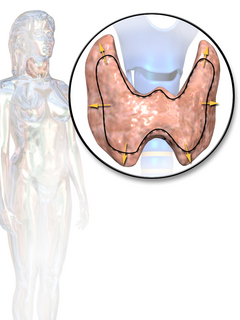
Lichen planus (LP) is a chronic inflammatory and immune mediated disease that affects the skin, nails, hair, and mucous membranes. It is characterized by polygonal, flat-topped, violaceous papules and plaques with overlying, reticulated, fine white scale, commonly affecting dorsal hands, flexural wrists and forearms, trunk, anterior lower legs and oral mucosa. Although there is a broad clinical range of LP manifestations, the skin and oral cavity remain as the major sites of involvement. The cause is unknown, but it is thought to be the result of an autoimmune process with an unknown initial trigger. There is no cure, but many different medications and procedures have been used in efforts to control the symptoms.
Keratosis pilaris (KP) is a common, autosomal dominant, genetic condition of the skin's hair follicles characterized by the appearance of possibly itchy, small, gooseflesh-like bumps, with varying degrees of reddening or inflammation. It most often appears on the outer sides of the upper arms,, thighs, face, back, and buttocks; KP can also occur on the hands, and tops of legs, sides, or any body part except glabrous (hairless) skin. Often the lesions can appear on the face, which may be mistaken for acne.
Granuloma faciale is an uncommon benign chronic skin disease of unknown origin characterized by single or multiple cutaneous nodules, usually occurring over the face. Occasionally, extrafacial involvement is noted, most often on sun-exposed areas.
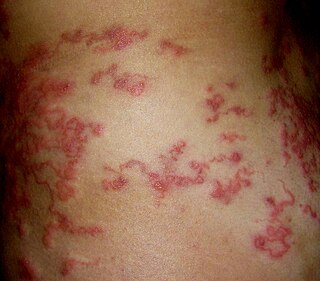
Cutaneous larva migrans is a skin disease in humans, caused by the larvae of various nematode parasites of the hookworm family (Ancylostomatidae). The most common species causing this disease in the Americas is Ancylostoma braziliense. These parasites live in the intestines of dogs, cats, and wild animals and should not be confused with other members of the hookworm family for which humans are definitive hosts, namely Ancylostoma duodenale and Necator americanus.
Photodermatoses is a skin disease that is caused by exposure to sunlight.People with photodermatoses may develop skin rashes following exposure to the sun. Polymorphous light eruption is the most common type of photodermatoses. It is most likely due to an abnormal immune system reaction to the sun. Polymorphous light eruption occurs in approximately 10 to 20 percent of otherwise healthy individuals, so it is a relatively common condition.
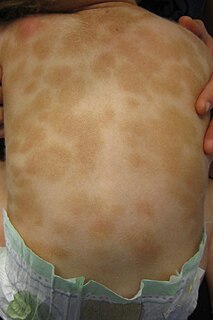
Urticaria pigmentosa is the most common form of cutaneous mastocytosis. It is a rare disease caused by excessive numbers of mast cells in the skin that produce hives or lesions on the skin when irritated.

Polymorphous light eruption (PLE), sometimes also called polymorphic light eruption (PMLE), is a non-life-threatening and potentially distressing skin condition that is triggered by sunlight and artificial UV exposure in a genetically susceptible person, particularly in temperate climates during the spring and early summer. Due to its many clinical appearances, it is named polymorphic or polymorphous and the terms are used interchangeably. The resulting itch can cause significant suffering.
Erythema toxicum neonatorum is a common rash in neonates. It appears in up to half of newborns carried to term, usually between day 2–5 after birth; it does not occur outside the neonatal period.
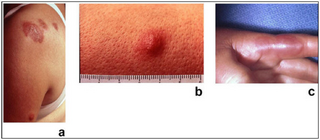
Sweet's syndrome (SS), or acute febrile neutrophilic dermatosis is a skin disease characterized by the sudden onset of fever, an elevated white blood cell count, and tender, red, well-demarcated papules and plaques that show dense infiltrates by neutrophil granulocytes on histologic examination.
Necrolytic migratory erythema (NME) is a red, blistering rash that spreads across the skin. It particularly affects the skin around the mouth and distal extremities; but may also be found on the lower abdomen, buttocks, perineum, and groin. It is strongly associated with glucagonoma, a glucagon-producing tumor of the pancreas, but is also seen in a number of other conditions including liver disease and intestinal malabsorption.
Dermatoses of pregnancy are the inflammatory skin diseases that are specific to women while they are pregnant. While some use the term 'polymorphic eruption of pregnancy' to cover these, this term is a synonym used in the UK for Pruritic urticarial papules and plaques of pregnancy, which is the commonest of these skin conditions.

Grover's disease (GD) is a polymorphic, pruritic, papulovesicular dermatosis characterized histologically by acantholysis with or without dyskeratosis. Once confirmed, most cases of Grover's disease last six to twelve months, which is why it was originally called "transient". However it may last much longer. Nevertheless, it is not to be confused with relapsing linear acantholytic dermatosis.
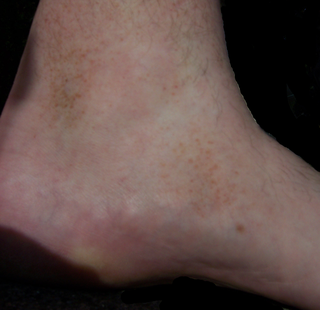
Schamberg's disease, is a chronic discoloration of the skin found in people of all ages, usually affecting the legs. It slowly spreads throughout the body, and is most common in males. It is named after Jay Frank Schamberg, who described it in 1901. There is no known cure for this disease and it is not a life-threatening condition. The skin lesions may cause itching, which can be treated by applying cortisone cream. The cortisone cream will only help with the itching and the discoloration of the skin will remain, which may cause a cosmetic concern in the future. Schamberg's disease is usually asymptomatic meaning that it shows no signs of this condition, except for the discoloration of the skin. This condition is caused by leaky blood vessels, where red blood cells escape near the surface of skin and release iron into the surrounding tissue. The cause of the leaky capillaries is unknown.

Ancylostoma braziliense is a species of hookworm belonging to the genus Ancylostoma. It is an intestinal parasite of domestic cats and dogs. Severe infection is often fatal to these pets, especially in puppies and kittens. The infection is particularly endemic in the southern United States. It is most often confused with the zoonotic hookworm species Ancylostoma ceylanicum because of their uncanny resemblance.
Fixed drug reactions, also known as fixed drug eruptions, are common and so named because they recur at the same site with each exposure to a particular medication. Medications inducing fixed drug eruptions are usually those taken intermittently.
Lichen striatus is a rare skin condition that is seen primarily in children, most frequently appearing ages 5–15. It consists of a self-limiting eruption of small, scaly papules.
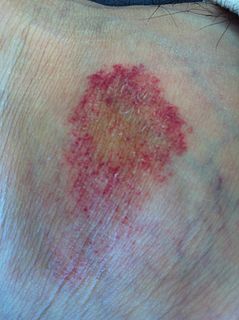
Pigmented purpuric dermatosis refers to one of the three major classes of skin conditions characterized by purpuric skin eruptions.
Asymmetric periflexural exanthem of childhood (APEC) is a rare, self-limited and spontaneously resolving skin rash of the exanthem type with unknown cause that occurs in children. It occurs primarily in the late winter and early spring, most common in Europe, and affecting girls more often than boys.
Sarcoidosis involves the skin in about 25% of patients. The most common lesions are erythema nodosum, plaques, maculopapular eruptions, subcutaneous nodules, and lupus pernio. Treatment is not required, since the lesions usually resolve spontaneously in two to four weeks. Although it may be disfiguring, cutaneous sarcoidosis rarely causes major problems.

